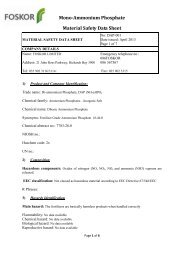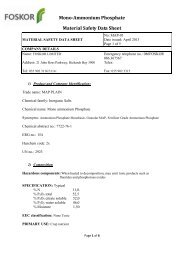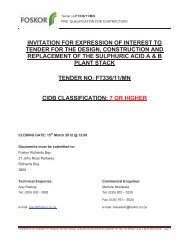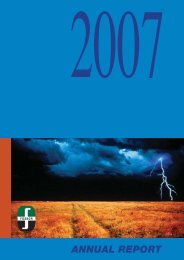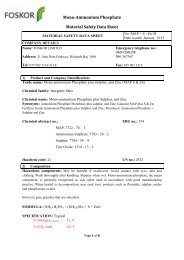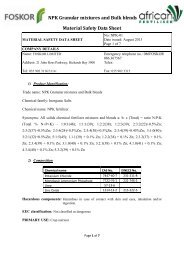Sulphuric Acid 98 - Foskor
Sulphuric Acid 98 - Foskor
Sulphuric Acid 98 - Foskor
You also want an ePaper? Increase the reach of your titles
YUMPU automatically turns print PDFs into web optimized ePapers that Google loves.
FOSKOR LIMITED<br />
Material Safety Data Sheet<br />
MATERIAL SAFETY DATA SHEET<br />
COMPANY DETAILS<br />
Name: FOSKOR LIMITED<br />
Address21 John Ross Parkway, Richards Bay<br />
3900<br />
Tel: 035 902 3116/3114<br />
No: Sulp.01<br />
Date issued: April 2013<br />
Page 1of 9<br />
Emergency telephone no.: 086 FOSKOR<br />
086 367567<br />
Telex:<br />
Fax: 035 902 3315<br />
1) Product and Company Identification: (Page 1 may be used as an emergency<br />
safety data sheet)<br />
Trade name: SULPHURIC ACID <strong>98</strong> %<br />
Chemical family: Inorganic <strong>Acid</strong><br />
Chemical name: <strong>Sulphuric</strong> acid<br />
Synonyms: Oil of vitriol; BOU; Dipping <strong>Acid</strong>; Vitriol Brown Oil; <strong>Sulphuric</strong>; <strong>Acid</strong> Mist;<br />
Chemical abstract no.: 7664-93-9<br />
ERG no.: 137<br />
Hazchem code: 2pe<br />
UN no.: 1830<br />
2) Composition<br />
Hazardous components: SULPHURIC ACID <strong>98</strong> %<br />
POISON! DANGER! CORROSIVE. LIQUID AND MIST CAUSE SEVERE BURNS TO ALL<br />
BODY TISSUE. MAY BE FATAL IF SWALLOWED OR CONTACTED WITH SKIN.<br />
HARMFUL IF INHALED. AFFECTS TEETH. WATER REACTIVE. CANCER HAZARD.<br />
STRONG INORGANIC ACID MISTS CONTAINING SULFURIC ACID CAN CAUSE<br />
CANCER. Risk of cancer depends on duration and level of exposure.<br />
R Phrases: R35 R36 R37 R38 R49.<br />
Page 1 of 7
3) Hazards Identification<br />
Main hazard: Danger! Extremely corrosive! Causes severe burn and eye damage. Strong<br />
inorganic acid mists containing sulfuric acid are carcinogenic. Harmful if inhaled. Harmful or<br />
fatal if swallowed. Reacts violently with water. Concentrated Sulfuric <strong>Acid</strong> will react with many<br />
organic materials and may cause fire due to the heat of the reaction. Not flammable, but reacts<br />
with most metals to form explosive/flammable hydrogen gas. Read the entire MSDS for a more<br />
thorough evaluation of the hazards.<br />
Eye effects: eyes: Corrosive. Contact can cause blurred vision, redness, pain and severe tissue<br />
burns. Can cause blindness.<br />
Health effects - skin: Corrosive. Symptoms of redness, pain, and severe burn can occur.<br />
Circulatory collapse with clammy skin, weak and rapid pulse, shallow respirations, and scanty<br />
urine may follow skin contact or ingestion. Circulatory shock is often the immediate cause of<br />
death.<br />
Health effects - ingestion: Corrosive. Swallowing can cause severe burns of the mouth, throat,<br />
and stomach, leading to death. Can cause sore throat, vomiting, and diarrhoea. Circulatory<br />
collapse with clammy skin, weak and rapid pulse, shallow respirations, and scanty urine may<br />
follow ingestion or skin contact. Circulatory shock is often the immediate cause of death.<br />
Health effects - inhalation: Inhalation produces damaging effects on the mucous membranes and<br />
upper respiratory tract. Symptoms may include irritation of the nose and throat, and laboured<br />
breathing. May cause lung oedema, a medical emergency.<br />
Carcinogenicity: The International Agency for Research on Cancer (IARC) has concluded that<br />
occupational exposure to strong inorganic acid mists containing sulphuric acid is carcinogenic to<br />
man, causing cancer of the larynx (the voice box) and, to a lesser extent, the lung. Although no<br />
direct link has been established between exposure to sulphuric acid itself, and cancer in man,<br />
exposure to any mist or aerosol during the use of this product should be avoided and, in any case,<br />
keep exposures below the occupational exposure limit for sulphuric acid<br />
4) First-aid Measures<br />
Product in eye: Immediately flush eyes with gentle but large stream of water for at least 15<br />
minutes, lifting lower and upper eyelids occasionally. Call a physician immediately<br />
Product on skin: In case of contact, immediately flush skin with plenty of water for at least 15<br />
minutes while removing contaminated clothing and shoes. Wash clothing before reuse. Excess<br />
acid on skin can be neutralized with a 2% solution of bicarbonate of soda. Call a physician<br />
immediately<br />
Product ingested: DO NOT INDUCE VOMITING. Give large quantities of water. Never give<br />
anything by mouth to an unconscious person. Call a physician immediately.<br />
Product inhaled: Remove to fresh air. If not breathing, give artificial respiration. If breathing<br />
is difficult, give oxygen. Call a physician immediately.<br />
Page 2 of 7
Note to Physicians: This product contains materials that may cause severe pneumonitis if<br />
aspirated. If ingestion has occurred less than 2 hours earlier, carry out careful gastric lavage; use<br />
endotracheal cuff if available, to prevent aspiration. Observe patient for respiratory difficulty<br />
from aspiration pneumonitis. Give artificial resuscitation and appropriate chemotherapy if<br />
respiration is depressed. Following exposure the patient should be kept under medical review for<br />
at least 48 hours as delayed pneumonitis may occur. DO NOT attempt to neutralize the acid with<br />
weak bases since the reaction will produce heat that may extend the corrosive injury<br />
5) Fire-fighting Measures<br />
Not considered to be a fire hazard. However if involved in a fire will emit toxic fumes including<br />
sulphuric acid fumes and sulphur dioxide. Reaction with certain metals will produce flammable<br />
hydrogen gas, which will burn if ignited. Heating may cause expansion or decomposition leading<br />
to violent rupture of containers. Fire fighters to wear self contained breathing apparatus and full<br />
protective clothing when fighting fire.<br />
Extinguishing media: Water fog (if unavailable water spray), foam, carbon dioxide or dry<br />
chemical powder.<br />
Protective clothing: In the event of a fire, wear full protective clothing and NIOSH-approved<br />
self-contained breathing apparatus with full face piece operated in the pressure demand or other<br />
positive pressure mode. Structural fire fighter’s protective clothing is ineffective for fires<br />
involving this material. Stay away from sealed containers.<br />
6) Accidental Release Measures<br />
Personal precautions: As a minimum use chemical-resistant gloves, eye/face and breathing<br />
protection.<br />
Environmental precautions: Downwind evacuation may be necessary<br />
Steps to be taken in the event of a spill or leak: Restrict access to area until completion of clean<br />
up. Ensure trained personnel conduct clean up. Remove all ignition sources (no smoking, flares,<br />
sparks or flames). All equipment should be grounded. Ventilate area. Use appropriate Personal<br />
Protection Equipment. Prevent liquid from entering sewers or waterways. Stop or reduce leak if<br />
safe to do so.<br />
Small spills: Cover with DRY earth, sand or other non-combustible material. Use clean nonsparking<br />
tools to collect material and place it into loosely covered plastic containers for later<br />
disposal<br />
Large spills: Prevent liquid from entering sewers or waterways. Dike with inert material (sand,<br />
earth, etc.). Collect into plastic containers for disposal. Consider in situ neutralization and<br />
disposal. Ensure adequate decontamination of tools and equipment following clean up. Comply<br />
with Federal, Provincial/State and local regulations on reporting releases<br />
Waste Disposal Methods: Dispose of waste material at an approved waste treatment/disposal<br />
facility, in accordance with applicable regulations. Do not dispose of waste with normal garbage<br />
or to sewer systems.<br />
Page 3 of 7
7) Handling and Storage<br />
Store in a cool, dry, ventilated storage area with acid resistant loors and good drainage. Protect<br />
from physical damage. Keep out of direct sunlight and away from heat, water, and incompatible<br />
materials. Do not wash out container and use it for other purposes. When diluting, always add the<br />
acid to water; never add water to the acid. When opening metal containers, use non-sparking tools<br />
because of the possibility of hydrogen gas being present. Containers of this material may be<br />
hazardous when empty since they retain product residues (vapours, liquid); observe all warnings<br />
and precautions listed for the product.<br />
8) Exposure Control/Personal Protection<br />
Occupational exposure limits: Work safe exposure standard for constituent <strong>Sulphuric</strong> <strong>Acid</strong> are:<br />
TWA: 1mg/m3<br />
STEL: 3mg/m3<br />
Engineering control measures: Ensure ventilation is adequate and that air concentration of<br />
components is controlled below the Exposure Standard. Use with local exhaust ventilation or<br />
while wearing acid mist respirator or air supplied mask. Keep containers closed when not in use.<br />
Personal protection - respiratory: If the exposure limit is exceeded and engineering controls are<br />
not feasible, a full face piece respirator with an acid gas cartridge and particulate filter (NIOSH<br />
type N100 filter) may be worn up to 50 times the exposure limit, or the maximum use<br />
concentration specified by the appropriate regulatory agency or respirator supplier, whichever is<br />
lowest. If oil particles (e.g. lubricants, cutting fluids, glycerine, etc.) are present, use a NIOSH<br />
type R or P particulate filter. For emergencies or instances where the exposure levels are not<br />
known, use a full-face piece positive-pressure, air-supplied respirator. WARNING: Air purifying<br />
respirators do not protect workers in oxygen-deficient atmospheres. Where respirators are<br />
required, you must have a written program covering the basic requirements in the OSHA<br />
respirator standard. These include training, fit testing, medical approval, cleaning, maintenance,<br />
cartridge change schedules, etc. See 29CFR1910.134 for details.<br />
Personal protection - eye: Use chemical safety goggles and/or a full face shield where splashing<br />
is possible. Maintain eye wash fountain and quick-drench facilities in work area.<br />
Personal protection - skin: Wear impervious protective clothing, including boots, gloves, lab<br />
coat, apron or coveralls, as appropriate, to prevent skin contact.<br />
Other protection: A system of local and/or general exhaust is recommended to keep employee<br />
exposures below the Airborne Exposure Limits. Local exhaust ventilation is generally preferred<br />
because it can control the emissions of the contaminant at its source, preventing dispersion of it<br />
into the general work area.<br />
9) Physical and Chemical Properties<br />
Appearance: Colourless to slightly yellow liquid of oily consistency,<br />
Odour: odourless.<br />
pH:
Boiling point: 338°C<br />
Melting point: <strong>98</strong>%: -1.1°C (30°F)<br />
Flash point: No known fire hazard.<br />
Vapour pressure:
Epidemiology: Workers exposed to industrial sulfuric acid mist showed a statistical increase in<br />
laryngeal cancer. This data suggests a possible relationship between carcinogenisis and inhalation<br />
of sulfuric acid mist.<br />
Neurotoxicity: No data available.<br />
Reproductive hazards: Slightly embryo toxic in rabbits (a minor, rare skeletal variation). The<br />
animals were exposed to 5 and 20 mg/m 3 for 7 hrs/day throughout pregnancy. Slight maternal<br />
toxicity was present at the highest dose in both species<br />
12) Ecological Information<br />
Ecotoxic Effects: Harmful to aquatic life in very low concentrations. May be dangerous if it<br />
enters water intake. Fish toxicity; 2.8 µg/L 96 hrs LC50 Rainbow trout<br />
Environmental Fate: When released into the soil, this material may leach into groundwater.<br />
When released into the air, this material may be removed from the atmosphere to a moderate<br />
extent by wet deposition. When released into the air, this material may be removed from the<br />
atmosphere to a moderate extent by dry deposition.<br />
Environmental Toxicity: LC50 Flounder 100 to 330 mg/l/48 hr aerated water/Conditions of<br />
bioassay not specified; LC50 Shrimp 80 to 90 mg/l/48 hr aerated water /Conditions of bioassay<br />
not specified; LC50 Prawn 42.5 ppm/48 hr salt water /Conditions of bioassay not specified.<br />
13) Disposal Considerations<br />
Disposal methods: There are no uniform EC regulations for the disposal of chemicals or<br />
residues. Chemical residues generally count as special waste. The disposal of the latter is<br />
regulated in the EC member countries through corresponding laws and regulations. We<br />
recommend that you contact the authorities in charge or approved waste disposal companies,<br />
which will advise you on how to dispose of special waste.<br />
Disposal of packaging: Disposal in accordance with local legal provisions.<br />
14) Transport Information<br />
UN no. 1830<br />
Substance identity no. 8<br />
IMDG - shipping name: <strong>Sulphuric</strong> <strong>Acid</strong><br />
IMDG Code: 8220<br />
MDG - class: 8 Corrosive Group: II<br />
IMDG - packaging group: II<br />
IMDG - marine pollutant: yes<br />
Page 6 of 7
Tremcard no.: 10B/80G03<br />
15) Regulatory Information.<br />
EEC hazard classification: 8 - Users should ensure that they comply with relevant legislation.<br />
Dangerous Substances Directive 67/548/ECC<br />
Risk phases: R35 R36 R37 R38 R49.<br />
Safety phases: S2 S23 S30 S36 S37 S39 S45.<br />
National legislation: The Occupational Health and Safety Act, 1993 (Act No. 85 of 1993)<br />
16) Other Information<br />
Reason for Alteration: General update.<br />
This information and product are furnished on the condition that the person receiving them shall make their<br />
own determination as to suitability of the product for their particular purpose and on the condition that they<br />
assume the risk of their use thereof. The conditions and use of this product are beyond the control of <strong>Foskor</strong><br />
(Pty) Ltd, and <strong>Foskor</strong> (Pty) Ltd disclaims any liability for loss or damage incurred in connection with the<br />
use or misuse of this substance.<br />
<strong>Foskor</strong> (Pty) Ltd believes the information contained herein is accurate. However, <strong>Foskor</strong> (Pty) Ltd makes<br />
no guarantees or warranties with respect to such accuracy and assumes no liability in connection with the<br />
use of the information contained herein by any party. The provision of the information contained herein by<br />
<strong>Foskor</strong> (Pty) Ltd is not intended to be and should not be construed as legal advice or as ensuring<br />
compliance by other parties. Judgments as to the suitability of the information contained herein for the<br />
party’s own use or purposes are solely the responsibility of that party. Any party handling, transferring,<br />
transporting, storing, applying or otherwise using this product should review thoroughly all applicable<br />
laws, rules, regulations, standards and good engineering practices. Such thorough review should occur<br />
before the party handles, transfers, transports, stores, applies or otherwise uses this product.<br />
Page 7 of 7



